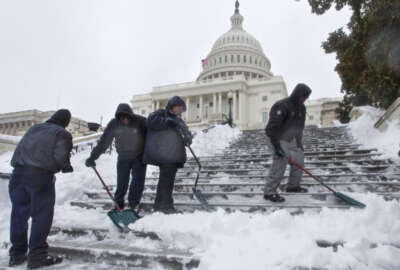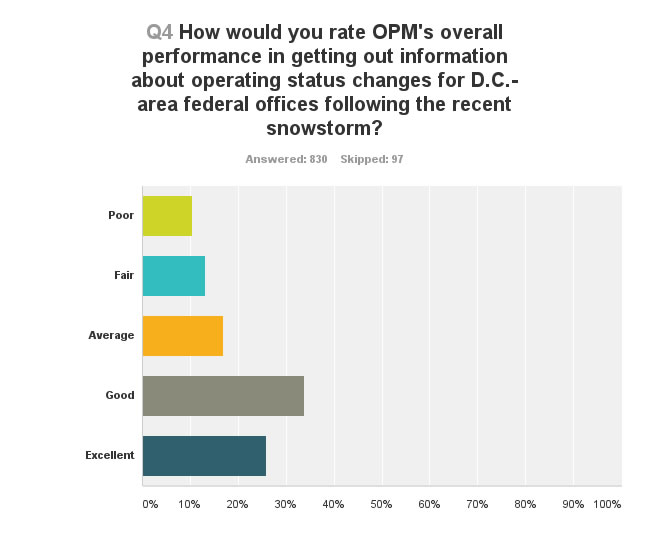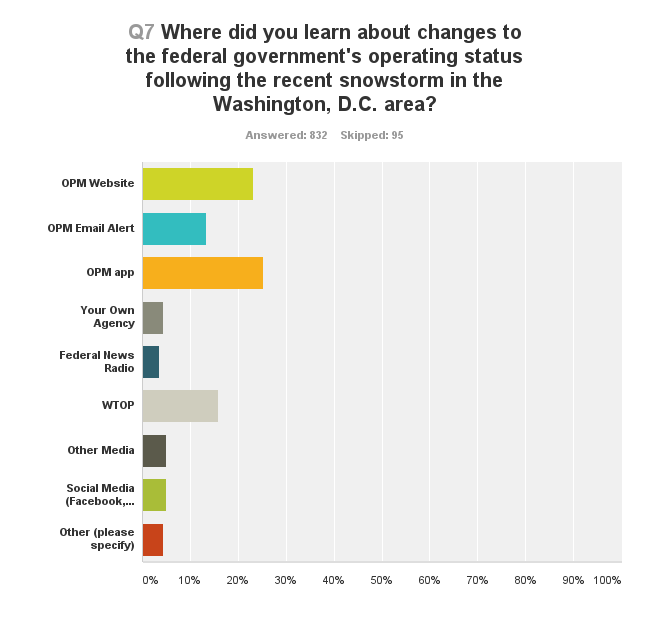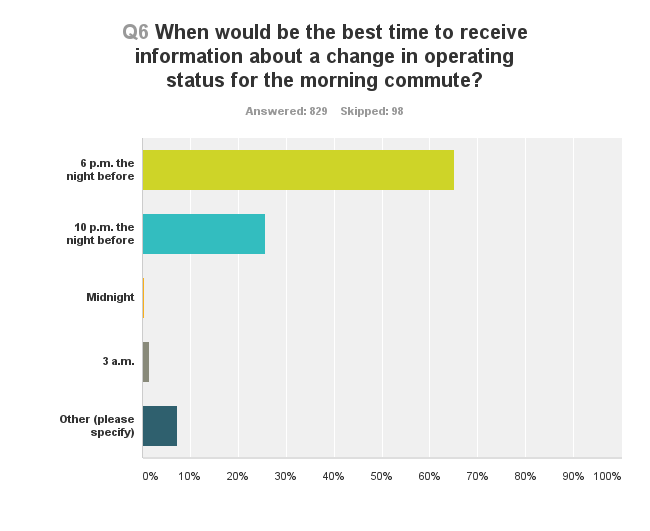
Exclusive
Feds give good marks for OPM’s handling of Snowstorm Jonas, still want earlier notification
Respondents to Federal News Radio's survey on how well the Office of Personnel Management handled getting out information about operating status overall gave the...
The remnants of Snowstorm Jonas have mostly thawed, and with them, opinions on how the Office of Personnel Management handled D.C.-area federal office operating status.
In a recent survey conducted by Federal News Radio, a majority of the more than 800 respondents rated OPM’s overall performance as good or excellent, but many also voiced that they would like to know earlier about a change in operating status.
“I understand 6 p.m. might be too early to get all information from all government/transportation parties,” wrote one respondent. “10 p.m. is a little too late … many of us have already gone to bed, with visions of closures dancing in our heads. It makes for an uncomfortable, anxious sleep, not knowing if/when to set the alarm, and sleeping lightly to hear every text and e-mail. It’s a little thing … but two hours makes a difference.”
According to the survey, 65 percent of respondents said the best time to receive information about operating status would be 6 p.m. the night before. Only 211 people, or about 26 percent of respondents, said 10 p.m. the night before was an appropriate time.
“10pm the night before is not a reasonable time to make a decision,” one person said. “People have to make plans, find childcare etc. One can’t do that after 10pm. Ridiculous. Make the decision by 6pm like everyone else.”
With meteorologists guaranteeing nearly 2 feet of snow for the area during the weekend of Jan. 26-28, OPM closed D.C.-area offices at noon Jan. 26, and kept those offices closed the following Monday and Tuesday, as transportation crews worked to clear roads and sidewalks of the tons of snow that buried the region. OPM decided to delay D.C.-area office openings by three hours on Jan. 27 and 28. The announcements were generally made public after 10 p.m.
“The notification PROCESS is fine, it’s the timing and decisions that are the problem,” wrote another survey taker.
“Aim for a consistent announcement time — 6:00 p.m. would be best, but 10:00 is fine if it’s consistent. 3:00 a.m. is too late,” someone suggested.
For its part, OPM takes its dismissal and closure decisions “very seriously,” an OPM spokesman said.
“We know they have impact throughout the DC region. That is why we make the decisions as early as possible. However, it can only be done after working closely with the Council of Governments (COG), and carefully evaluating the information we gather from around the region, including road and transit conditions, the status of snow removal equipment, and incoming weather forecasts. We also coordinate with other entities — like WMATA and the departments of Transportation for the region — to ensure that they know the working ‘status’ of federal employees. As soon as the decision is made, OPM’s website is updated and a ‘status alert’ email is sent to OPM’s senior staff, members of the media and to individuals who have downloaded the OPM Alert app.”

According to the survey, 23 percent of respondents learned about the federal government’s operating status through OPM’s website, while 25 percent of respondents used OPM’s app to find out whether they had a snow day. About 13 percent received OPM’s email alert.
“You are never going to make all govt. employees happy,” one respondent observed. “I live in Waldorf and commute to Chantilly. The 27th and 28th commutes were OK for me. I think the telework thing is the way to go for those in DC that can do it. Buses and Metro have to be running a normal schedule to facilitate the commute of the feds.”
“This is the best OPM has ever done riding that line between keeping staff safe, assisting local/state municipalities by keeping govt workers off the roads and being sensitive to the public’s perception about govt workforce efficiency,” a respondent wrote. “I don’t have any idea, other than trying to make the call earlier, that they could improve the process. Every storm is unique so a one-size-fits-all approach is impractical. I think OPM did a great job.”
When asked to rate OPM’s overall performance getting out the word on changes to the operating status, about 34 percent of respondents said the agency did a good job, while about 26 percent said OPM did an excellent job. Only 11 percent answered that the agency gave a poor performance during the storm.
One survey taker credited the agency with doing a great job and keeping federal employees informed thanks to its “beautifully designed website,” but also put the responsibility of knowing when to work on the federal workers.
“People have to be responsible and CHECK IT … they cannot have everything handed to them. It’s called Personal Responsibility, and it’s not about improving OPM’s operating status notification process, but instead about an individual taking charge of checking the tools that have been made available to them! (Please STOP fostering this “gimme” mentality!),” the respondent said.
Roughly one-third of respondents said OPM’s performance was slightly better than previous years in getting out the word on operating status changes, while a quarter of respondents each thought that OPM’s performance was about the same or much better than previous years.
Ninety-five percent of survey respondents said they worked in the D.C.-metro region. Of the 919 survey respondents, 373 — or 41 percent — said they worked for a civilian agency, with about 20 percent of respondents answering that they worked for the Department of Defense or the executive branch. Nearly 70 percent of respondents said they were between the GS 13-15 grade level or equivalent.
In Federal News Radio’s survey, we asked respondents who lived outside the region to weigh in on the operating status notification process for their region and offer any suggestions.
About 35 percent of respondents said the notification process was poor, while 21 percent said it was fair. Roughly 24 percent of respondents said the process was excellent.

Some respondents who live outside the Capital Beltway echoed similar sentiments that OPM make an announcement earlier in the evening. Others answered with more emphasis on weighing the quality of roads and highways.
“Consider the road conditions throughout the area, within a 50 mile radius,” wrote one respondent. “Make certain the parking lots are free of snow since so many times they are not and that is how people fall and hurt themselves.”
“I do not work in DC, I work in WV and we got 28″ of snow in our area. We were not given any time off, we had to report to work on Monday. We had poor road conditions to drive on. If we need to report to work so should DC,” answered another person.
OPM officials said what is most important in making an operating status decision is the “safety of the federal workforce while, at the same time, making sure the important work of the government continues to be done on behalf of the American people.”
That means it’s unlikely that one respondent will get their wish for winter weather operating status: “Stay closed until spring.”
Federal employees can check the current operating status in the Washington, D.C. area here.
Employees can also download the OPM Alert Mobile App in order to monitor the current operating status and receive push notifications of changes to the status.
Want to keep up with the latest news about the federal government — including government closures and changes in operating status? Sign up for Federal News Radio email alerts.
Copyright © 2025 Federal News Network. All rights reserved. This website is not intended for users located within the European Economic Area.




